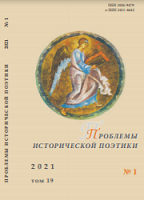«Теория русского лада» Алексея Ремизова (1930‒1950-е годы)
A. M. Remizov’s “Theory of Russian Literary Style” (1930s-1950s)
Author(s): Alla GrachevaSubject(s): Russian Literature, Interwar Period (1920 - 1939), WW II and following years (1940 - 1949), Theory of Literature
Published by: Петрозаводский государственный университет
Keywords: Aleksei Remizov; teoriya russkogo lada; theory of Russian literary style; style; prose of the twentieth century;
Summary/Abstract: The article analyzes the stages of development of A. M. Remizov’s “theory of Russian literary style” (“teoriya russkogo lada”) in the 1930s-1950s. In the 1930s, the opportunities for the writer to present his aesthetic views in an open journalistic form narrowed down significantly. Remizov was forced to popularize his theory and the name of its “founder” - protopope Avvakum in works devoted to other topics (Knigopisets i shtanba, Po sledam protopopa Avvakuma v SSSR, etc.). In these years, the conceptual apparatus of the theory has taken shape, the semantics of the term “theory of Russian literary style” was detailed. In 1946, Remizov made the last, unsuccessful attempt to publish an introduction to his theory in the form of a manifesto (Na russkiy lad, 1946). The exposition of this theory’s postulates was an indispensable part of most of Remizov’s works of the late 1940s-1950s. Plyashuschiy Demon (The Dancing Demon), an avant-garde book, reveals the ongoing confrontation between the supporters and opponents of the “theory of Russian literary style” up to the 20th century through a historical kaleidoscope of characters from different periods of Russian history. Related novels. i. e. Uchitel muzyki (The Music Teacher) and Podstrizhennymi glazami (By Cropped Eyes) are devoted to examining the mystery of the formation of a writer’s personality, and reflect the Russian art life in the 19th-20th centuries and in the first wave of Russian emigration. The writer’s emerging personality, the formation of its aesthetic foundation is historically and culturally justified in both books. The writer in question is a follower of “theory of Russian literary style”. This very theme is one of the central topics in Remizov’s latest work - his book about himself - Litso pisatelya (The Face of a Writer).
Journal: Проблемы исторической поэтики
- Issue Year: 19/2021
- Issue No: 1
- Page Range: 347-374
- Page Count: 28
- Language: Russian

